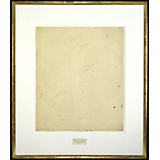 My first sense of the modern is in what Roger Shattuck said about Marcel Duchamp: “Can one produce works that are not works of art? He tried; we wouldn’t allow it.â€
My first sense of the modern is in what Roger Shattuck said about Marcel Duchamp: “Can one produce works that are not works of art? He tried; we wouldn’t allow it.â€
One might say of Robert Rauschenberg: “Can one throw out something that is pure junk? We tried; he wouldn’t allow it.â€
My second sense of the modern is in Rauschenberg’s famous early work, Erased de Kooning Drawing (1953). Which is exactly that: He talked Willem de Kooning into giving him a drawing to erase. He wanted to start with a drawing that was “a hundred percent art,†which he thought his own might not be. De Kooning gave him something hard, a heavy-lined piece drawn with grease pencil, ink and crayon. It took Rauschenberg a month and forty erasers, but he finished his un-drawing. (Calvin Tomkins, Off the Wall: Robert Rauschenberg and the Art World)
Erased de Kooning Drawing is now owned by the San Francisco Museum of Modern Art. Here’s its archival description: “Traces of ink and crayon on paper with mat and hand-lettered label in gold-leaf frame.†And what is the drawing’s art-historical significance? It counters “the Abstract Expressionist celebration of the meaning invested in the uniqueness of the artist’s touch,†for “nothing could be more contrary to this ethos than the repeated strokes of the eraser, the trace of which does not register the imprint of the worker’s identity but is instead a mechanized effacement of both the drawing’s marks and its own counterstrokes.†(Krauss, et al, Art Since 1900: Modernism, Antimodernism, Postmodernism)
But could anything be less anonymous or less mechanical? In fact, the erasure makes the drawing no longer there more real. No, it is simply an erased drawing. It is a great thing, and yet I ache for the drawing that disappeared under Rauschenberg’s intense scrutiny. That image must have burned into his brain. Or, perhaps not. Or, perhaps in time it un-burned. It is regret I feel when I think of it, sheer regret, for all the things I can know only in memory. And, more likely than not, remember only vaguely.
My third sense of modernity is Black Mountain, the short-lived college in North Carolina where Rauschenberg found himself, along with a scattering of others: John Cage, Merce Cunningham, Charles Olson, Robert Creeley, Denise Levertov, Buckminster Fuller, Cy Twombly, Robert Motherwell, and de Kooning, among many, many others, folks with heads so American and so far West they should have sprung from Haystack Rock.
Another Black Mountaineer, Jonathan Williams, said it all with the title of one of his books: The Magpie’s Bagpipe. The raucous magpie is a collector and hoarder, hard-headed and earth-hearted. There’s something hasty AND finished about the magpie’s confusion of a nest, what might be called scatter art! There’s a bit of magpie in all Black Mountain folk. My response to what they do is visceral. Thought springs wild from there.
Now it’s simply an erased drawing.